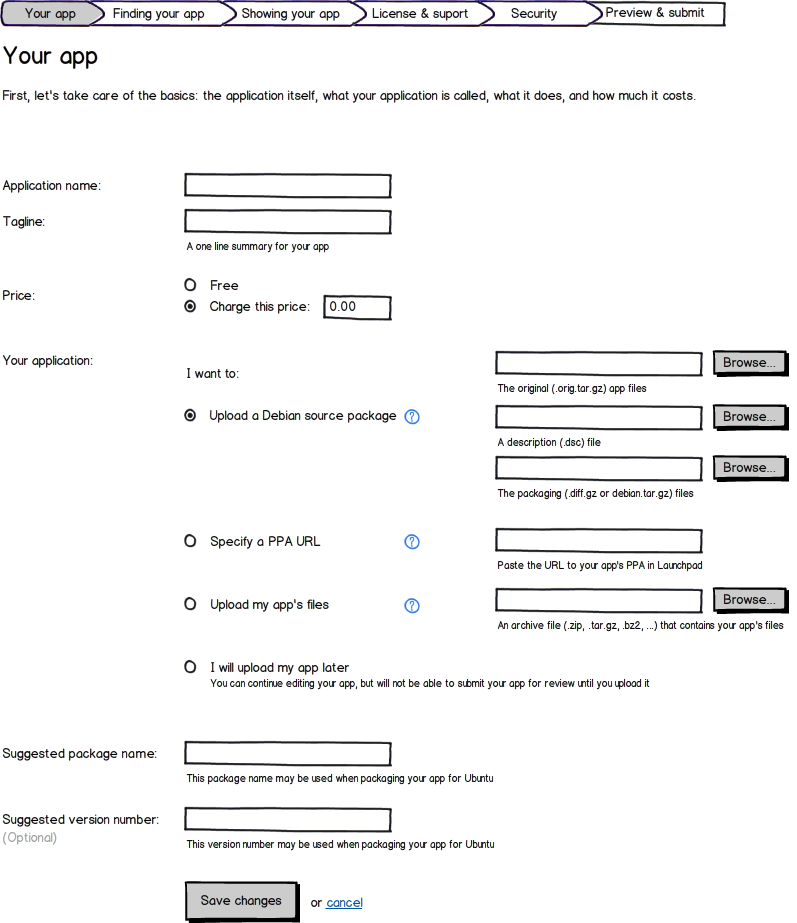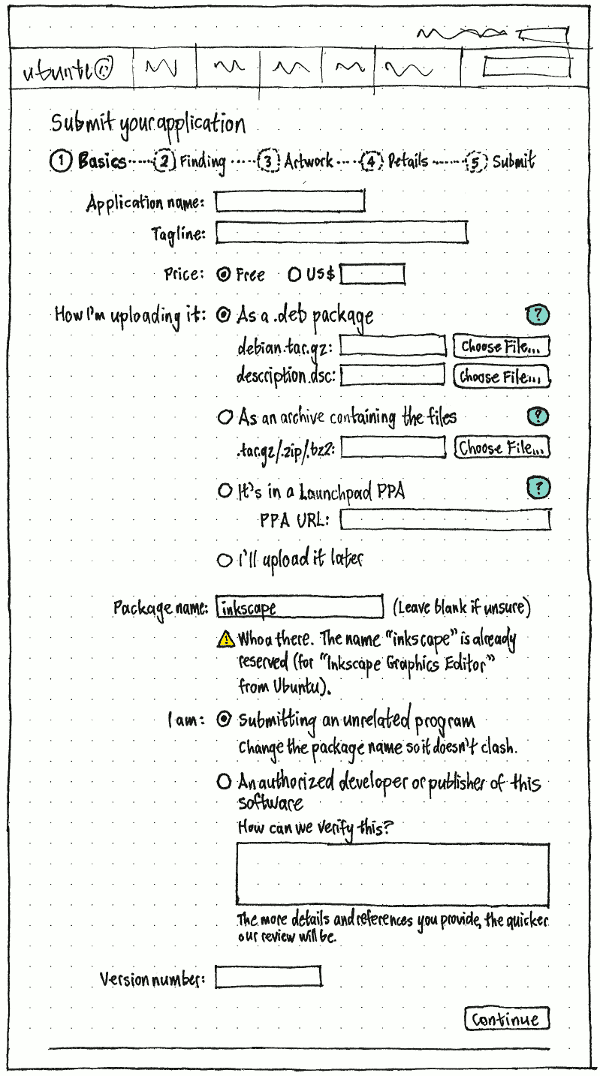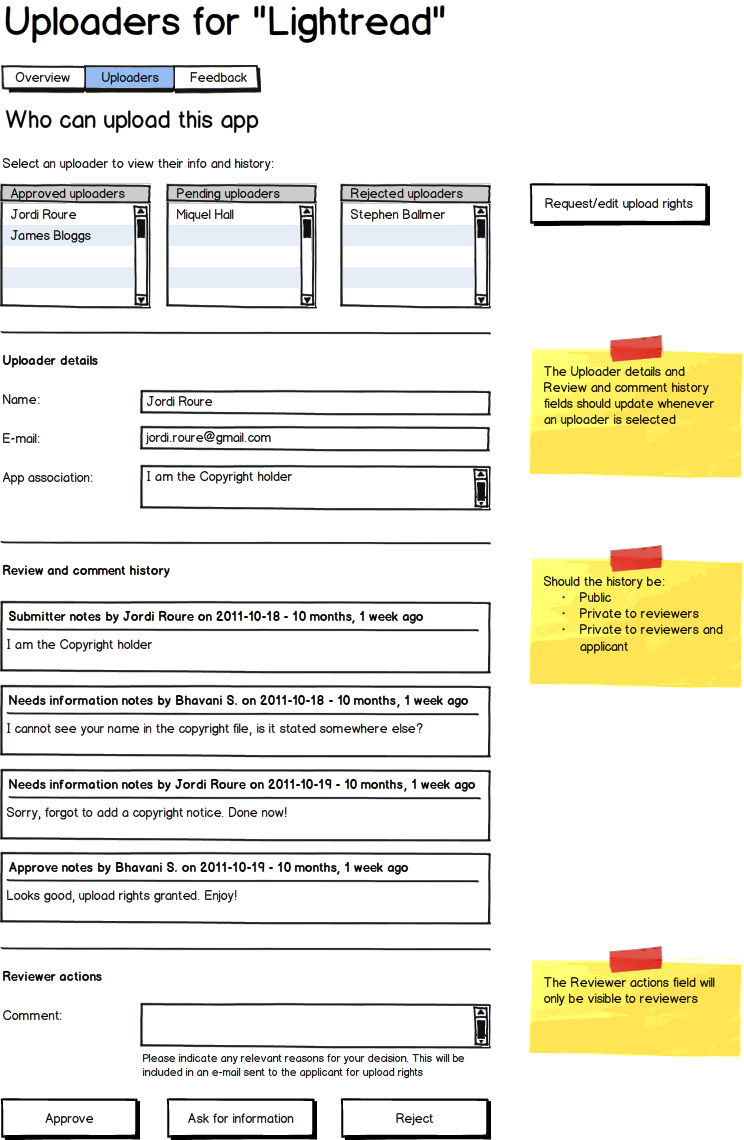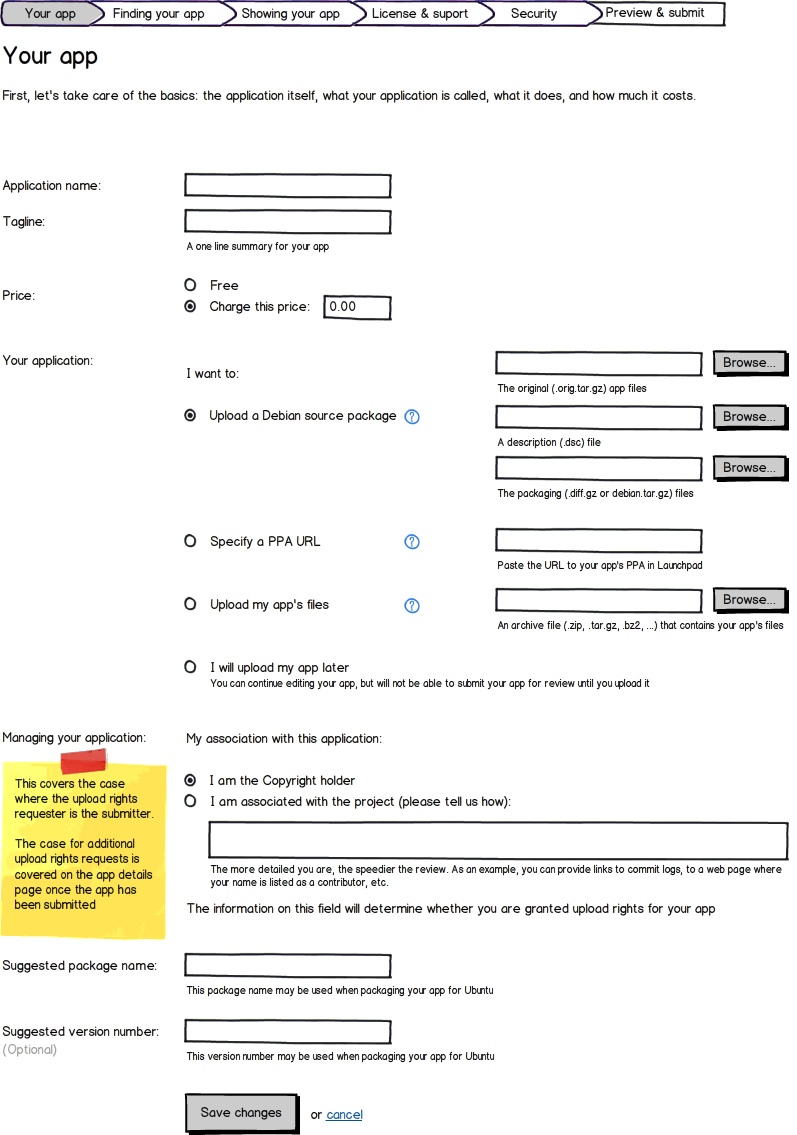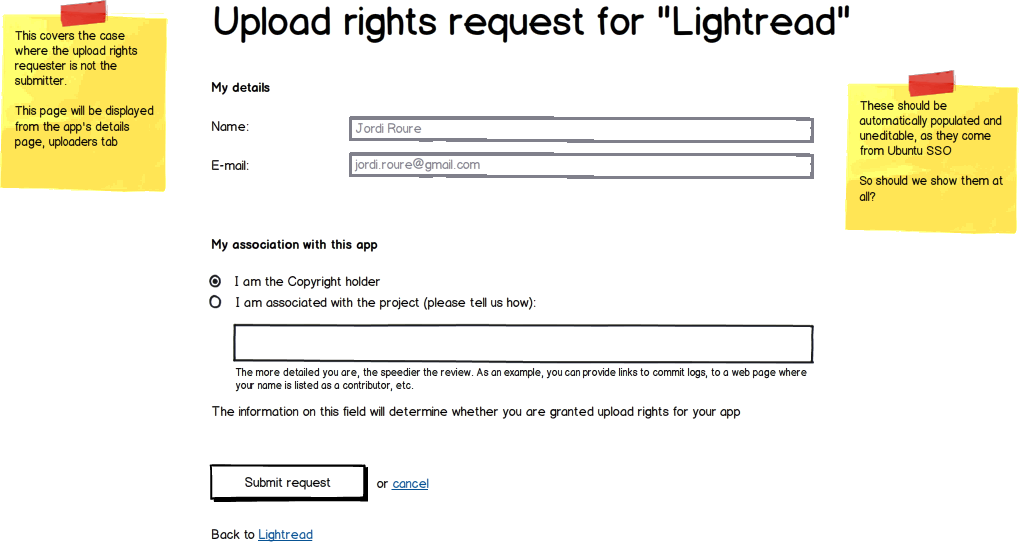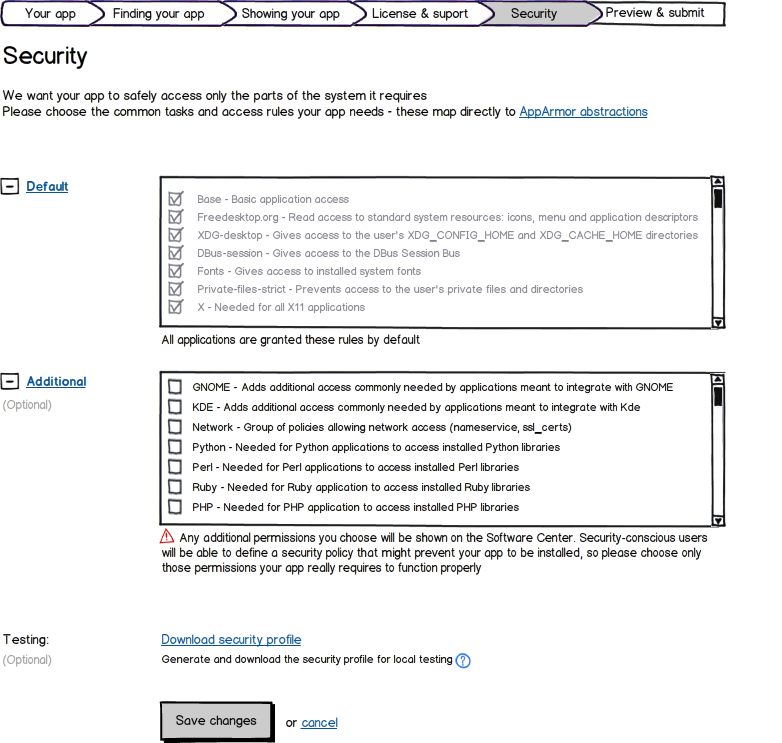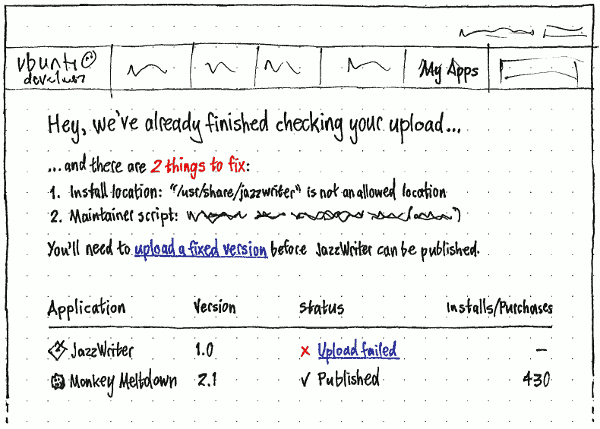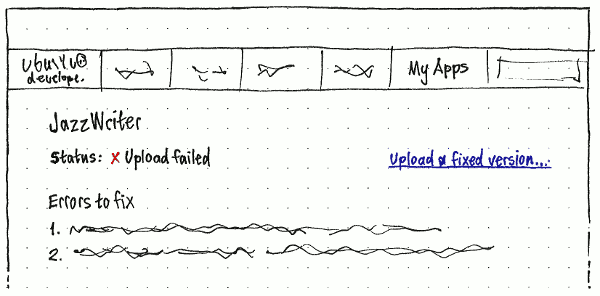AppDevUploadProcess
App Developer Upload Process
IMPORTANT: this has not been updated for click packages yet |
Please note: This is a work in progress specification and it is not complete. There are parts of the current draft that will change based on feedback and research we are currently doing. This spec's creation is being coordinated by Jono Bacon, David Planella, and Michael Hall. |
Problem
Today we face a significant challenge in Ubuntu. If an application author wants to get the latest version of their software in Ubuntu they have two options:
An Ubuntu developer packages the software and delivers it in the development release.
The app developer can submit their apps via MyApps in the stable release for review.
There are various challenges with these two approaches:
- For (1) app developers cannot get new releases of their software on stable releases. This results in versions of their software in Ubuntu being one or more releases behind the current stable version from upstream (we have seen app developers often not want to recommend the Ubuntu Software Center a place to get their software due to this issue).
- For (1) this requires knowing an Ubuntu developer who can help you or hoping that an Ubuntu developer cares about your software. This is less empowering for app developers who want to deliver their software directly into Ubuntu.
- For (2), if the developer is selling their software, they are reasonably well catered: the consumer apps team will take care of them delivering their apps into Ubuntu. For Free Software developers who use approach (2) they must do more work themselves. The Application Review Board (ARB) are there to review these apps but the ARB, as a team of volunteers, is not able to scale with increases in the queue (the recent App Developer Showdown was a good example of this), resulting in long delays for the developer. The ARB frequently gets messages from developers asking if something is wrong when they haven't heard back in 24 hours, and the developers often become discouraged after a delay of a week or so, thinking their work was wasted. A bad first experience gives them no motivation to improve their skills and come back for more.
For (2), the developer is often required to make changes to their application and packaging in order to comply with the different packaging and installation requirements for MyApps (such as the /opt requirement).
- Irrespective of whether the app dev uses (1) or (2), they are relying on other people to do work before they can deploy their application. This is less empowering, and for an emerging platform such as Ubuntu, we need to enable app developers to deliver their apps without such delays.
Goal
Please note: this specification only focused on applications that are uploaded to the Extras extension repository. Thus, this process does not cover developer uploads of newer versions of software in the existing main archive (which includes the main, restricted, universe and multiverse components). We do want to explore and discuss the best way to provide updates for main archive apps, but those are out of scope for the current revision of the spec. |
The goal here is to provide a safe, reliable means in which app developers can upload their stable releases directly into Ubuntu.
With this goal in mind we want to resolve the common bottlenecks that we have experienced with the current process for app developers:
We should not rely on manual reviews of software before inclusion. Manual reviews have been found to cause a significant bottleneck in the MyApps queue and they won’t scale effectively as we grow and open up Ubuntu to thousands of apps.
Requiring app installation into the /opt directory is significantly challenging to app developers and not well supported in Ubuntu; this should be made transparent to the developer.
We also want to enhance the platform experience for both users and developers who are building applications for Ubuntu:
- Provide a standard, stable and useful platform for developers, and a rapid path to delivering their apps to Ubuntu users
- Give users a safer access to the growing ecosystem of independent applications being developed for Ubuntu.
- Keep the user informed and in control over who is providing the software they install, and what access to their system it will have.
Proposed Solution
This section outlines the proposed solution for how app developers upload their apps, and how end users can browse a combination of apps delivered by Ubuntu/Debian developers as well as apps uploaded by app developers.
How App Devs Upload Their Apps
Here is a proposed solution to resolve these problems.
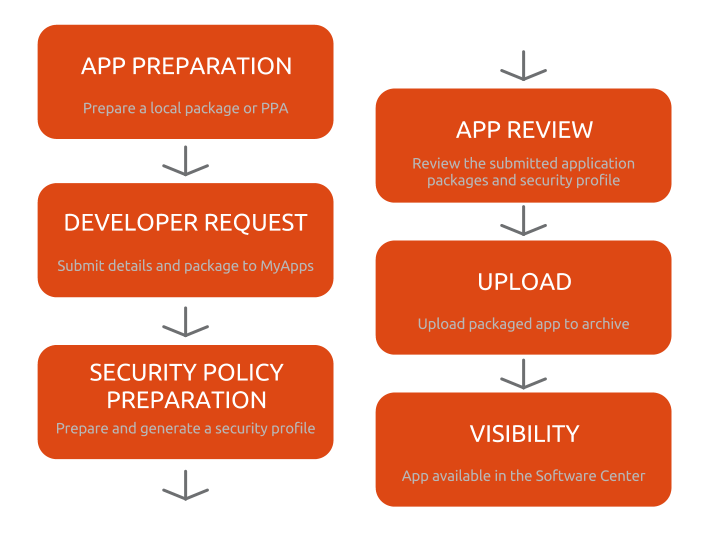
App Preparation - the developer can use our tools to generate a package to be included in the Ubuntu Software Center. These tools will likely include Quickly and pkgme to generate the package.
Developer Request - in MyApps the developer creates a request to upload their application through MyApps. The developer will be asked to provide proof that they are either (a) the copyright or trademark owner of the application or (b) a key representative of the team that created it (e.g. a core developer for an Open Source project) or (c) has the endorsement of the project to provide packages to Ubuntu. They will not be granted permissions to any package name currently in the Ubuntu archive. The developer will also be required to agree to terms and conditions that will clearly outline what content is acceptable and unacceptable, and that the software can be removed if questionable, illegal, or infringing content is found. Once approved the developer will be provided with upload access for that specific application to extras.
Security Policy Preparation - the developer then fills in a web form that outlines the resource requirements for the application. This will generate an AppArmor policy for the application and provide its access needs to the Software Center.
App Review - When the developer submits a new version of their application, it will go through a series of automated checks to verify that it conforms to the Extras packaging and security rules. The developer will be responsible for ensuring the package works effectively. If it doesn’t, the ratings and reviews will surely reflect this.
Upload - The developer is now able to upload versions of their package to the Ubuntu Software Center without each version requiring a specific review and thus achieving the goals highlighted in this spec. The developer will not be able to upload other packages, just the one they have access to upload. This upload will be performed by MyApps at the developer's request.
Visibility - When this version of the application appears in the Ubuntu Software Center it will be made clear that the application is provided by the developer, who is solely responsible for it. Users will be able to see a combination of applications provided by Ubuntu/Debian developers (which are supported) as well as developer-uploaded applications such as outlined by this process. See the next section for more details.
How End Users Browse Apps
The goal here is to ensure that Ubuntu users can make an informed choice about what applications they want to install. This informed choice should not only be based upon the features of the application but also how support the application is.
There are two types of application that the Ubuntu Software Center will show:
Officially supported apps - these are the apps in main that are supported as part of our support policy. These are likely to be older version but releases with assured integration and security fix support.
- Developer uploaded apps - these are the apps that app devs can upload. These are not supported by Ubuntu developers and the app developer is responsible for any quality and integration considerations.
We would need some design input on the best way of presenting this information.
Implementation
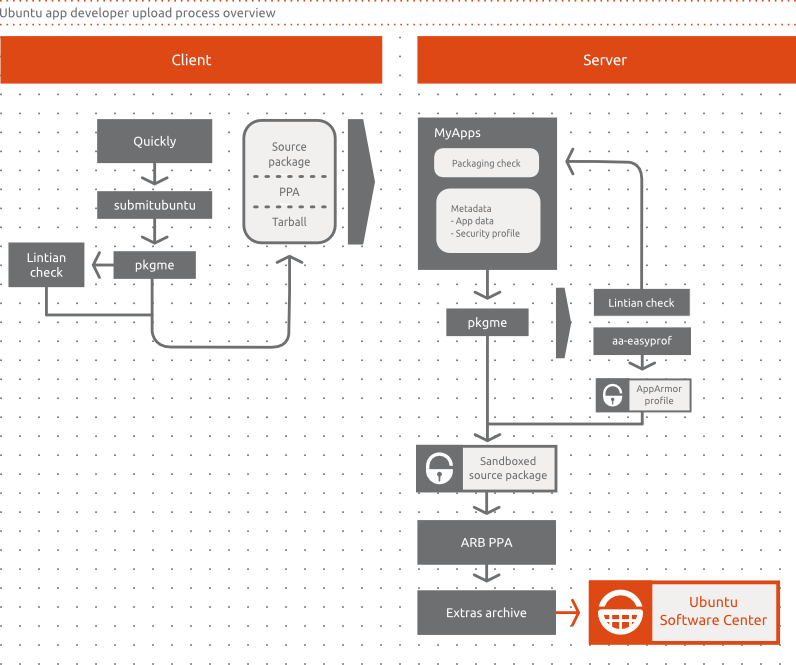
App Preparation
This step deals with how app authors will prepare their app before submitting it to MyApps and starting the app developer upload process. We want to be able to help and support our app developers to submit their applications in a format that can be easily processed for inclusion in the Ubuntu Software Center.
MyApps will accept one of the following formats (please note the priorities listed that indicate the order in which we want to build this support):
Debian source package (high priority) - this works out of the box with Quickly today and would be our recommend method of submitting content. On the server side, pkgme would unpack it to integrate the security profile into a newly-generated source package.
Source tarball (medium priority) - in this case app developers do not have to worry about packaging at all, as the package is generated automatically on the server side. Requires work on pkgme to implement an initial set of supported backends. We need to support this format for the long tail of app developers who will be bringing their apps to Ubuntu without any prior packaging experience.
PPA link (low priority) - this also works out of the box with Quickly and is simply a variation of the source package format format. This provides a useful means in which app developers can run a PPA for where they publish and test their packages and then simply nominate a a PPA package for release in the Ubuntu Software Center.
At the final stage of application development, when the author feels the application is ready to be published, they will be able to execute a Quickly command to prepare their code in a way that can be processed by MyApps. The command will be:
quickly submitubuntu
Alternately, the author will be able to manually submit their application through the MyApps web interface, selecting the source package files from their computer or directing MyApps to download them from a PPA. The goal is to ultimately create a package on the server side that can be distributed in the Software Centre.
Your app tab, upload controls, version I (click to zoom) |
Your app tab, upload controls, version II (click to zoom) |
We will continue requiring applications to be installed to /opt/, but will make this transparent to the developer by fully supporting relocatable packages in all of our build tools and runtime systems. Once relocation is supported, the developer will not need to make any changes to their source code or source package in order to target /opt/, they will only need to build the binary by passing a special flag to debuild. When their package is built by MyApps, the same flag will be used to ensure that the resulting binary will be properly installed into /opt/.
When needed for desktop integration, a set of whitelisted locations within /opt/ has been defined where applications will be able to install files. The same or equivalent set of tools will be run on the server side to do the checks.
The whitelist of approved installation locations is:
Whitelisted install location |
Notes |
/opt/extras.ubuntu.com/${appname}/ |
The bulk of an application's files will be installed here |
/opt/extras.ubuntu.com/share/applications/${appname}.desktop |
|
/opt/extras.ubuntu.com/share/applications/${appname}-*.desktop |
|
/opt/extras.ubuntu.com/share/unity/lenses/${appname}/ |
Needed for Unity lenses and scopes |
/opt/extras.ubuntu.com/share/dbus-1/services/${appname}.service |
DBus service files. The file names are in reverse domain naming notation (e.g. com.ubuntu.OneConf.service) |
/opt/extras.ubuntu.com/share/dbus-1/services/${appname}-*.service |
Same as above |
/opt/extras.ubuntu.com/share/glib-2.0/schemas/${appname}.gschema.xml |
GSettings schema files. The file names are in reverse domain naming notation (e.g. org.gnome.Evince.gschema.xml) |
/opt/extras.ubuntu.com/share/doc/${appname}/ |
|
/opt/extras.ubuntu.com/share/man/man{3,8}/${appname}*.*.gz |
|
/opt/extras.ubuntu.com/share/help/<lang>/${appname}/ |
|
/opt/extras.ubuntu.com/share/locale/<lang>/LC_MESSAGES/${appname}.mo |
|
/opt/extras.ubuntu.com/share/icons/hicolor/<size>/${appname}.{png,svg} |
|
/opt/extras.ubuntu.com/share/python/runtime.d/${appname}.rtupdate |
|
/opt/extras.ubuntu.com/share/apport/crashdb.conf.d/${appname}-crashdb.conf |
|
/opt/extras.ubuntu.com/share/accounts/${appname}/ |
Apps will only be allowed to install files in these locations – Permalink |
On the client side, Quickly and pkgme will integrate a custom Lintian profile to do the checks for whitelisted location (and any additional ones required) and will output warnings or errors to indicate whether the local app might need to be fixed before being submitted.
While this specification is concerned with apps created by the tools that Ubuntu provides (which in this case they are Quickly), app developers that write their apps outside Quickly should be able to get their software prepared in the same form Quickly does.
A further step towards better process automation would be to provide an API to enable Quickly to directly send the application to MyApps. While this would streamline the process, it is considered non-essential for the current revision of the spec.
Security Profile Testing
In order to iteratively test their application under an AppArmor security profile, developers will be provided with a tool that will generate and install a working profile built from a simple config file. This tool will be available as a stand-alone commandline program, as well as being integrated into Quickly. It will facilitate the creation and installation of a local AppArmor profile, as well as running the application under this profile to test it's functionality inside of the sandbox.
The tool will read a list of requested abstractions from a simple text file (INI, or other format), and apply those on top of the Ubuntu Application profile template using aa_easyprof. Developers using Quickly should be able to add and remove abstractions from this file using Quickly commands. Developers not using Quickly would still be able to edit the file by hand. The config file should be included as part of the source package submission so that it can be used by MyApps to pre-populate the security profile form for the developer.
Namespace conflict checking
Applications installed in a system may come from diffferent sources, that is, from different archives: mainly Main (including backports) and Extras (where apps concerned with this spec reside).
There is currently no infrastructure in place to provide a connection between the archives in terms of checking that their packages or the contents of those packages don't clash. This does not only apply to independent archives, but also to repositories within a self-contained archive. Also worth noticing is that this is not an issue introduced by this spec, but an already existing one.
In summary, there is a small but real possibility for packaged applications submitted through the app developer process to essentially (a) install files in the same location as another package coming from the Main archive or (b) to use a package name already in use in the Main archive.
Both cases would create a file or package conflict situation which the packaging tools would not be able to fix. Note that the potential scope for (a) would only affect the whitelisted set of installation locations for third party apps. Case (b) is further addressed in the Package preparation section by prepending the extras_ prefix to Extras packages to avoid collisions.
Conflict checker
A solution to this problem would be to use an automated conflict checker service. The idea is that the contents of all archives are read into a database and then a comparison is made upon any submission to MyApps. MyApps would query the conflict checker and would inform the submitter of any file conflicts that need to be fixed before upload.
The idea is that the conflict checker has data about all archives, but only runs for Extras before each upload: to inform the uploader about conflicts and prevent uploads until they have been resolved. If this proves to be a useful feature, it could theoretically be extended to all of the archives in a future iteration, so that not only Extras apps would benefit from conflict checking, but also all software in the Main archive.
For each new distro series, Extras will be open at Beta time. Just before opening the archive, the conflict checker will also be enabled for that release and will continue running for the lifecycle of the distro series. For newly submitted applications, conflicts will be detected and Extras uploads will be blocked until the conflicts have been resolved. For existing Extras applications which may present a conflict with a Main application, the Main application will take precedence in terms of file namespace ownership (as outlined below). In this case, an e-mail notification will be sent to the app developer to fix the conflict and reupload their app, and the Extras package will be marked with a Conflicts: field against the Main package. If the app developer does not act upon it, their app will be uninstalled when users do the upload to the stable release.
The conflict checker should be aware of and able to handle:
- Conflicts within the same archive
In terms namespace ownership, the proposal is to use the following priorities:
- Main
- Extras
- Backports
That means the archives that are higher on the list get to own the namespace when there is a conflict with an archive with a lower priority, and the uploaders on the lower priority archive need to resolve the conflict.
The current conflict checker (currently not in use) and the packages.ubuntu.com site are two examples of existing infrastructure using a similar approach.
Potential cases
John uploads "Wikitron" (/usr/bin/wikitron) to Extras via MyApps. Afterwards, Jane uploads "DesktopWiki" (also /usr/bin/wikitron) to Backports
- Solution: conflict checker warns Jane about the conflict via an e-mail. She must fix the conflict before a new upload is accepted.
George uploads "Lightread" (/usr/bin/lightread) to Extras through MyApps. An existing package called "LightReader" (/usr/bin/lightread) exists in the main archive already
Solution: conflict checker warns George about the conflict via an e-mail and on the MyApps web UI. He must fix the conflict before a new upload is accepted.
Herbert uploads "bird-game" (/usr/bin/bird-game) to Extras via MyApps. An existing package called "animal-games" (with /usr/games/bird-game) exists in the main archive already. Calls to "bird-game" will match the one in /usr/bin/ before the one in /usr/games/
- Solution: extend conflict checking to match any file under a directory in $PATH to any other file in a directory under $PATH. Possibly need to do the same for libraries.
Oswald uploads package "notes" to Extras via MyApps. Afterwards, Persephone uploads an unrelated package, also called "notes" to Debian. During the Ubuntu+1 package sync, Persephone's "notes" package will be pulled into Universe.
Solution: Prefix Extras packages with extras_ to avoid package name conflicts
If the package gets moved into Debian or Ubuntu's archives, we would need to transition the users who have the extras_ package installed over to the non-prefixed package.
Developer Request
Applying for access
To ensure that we are giving upload access only to the original author or a proper representative of the upstream project, we will require that person to request upload access for their application. The author or representative must first create an account and user profile in the MyApps portal as it currently exists.
Once their profile is created, they will need to be able to request upload access for a package, providing details about their association with the upstream project. If the submitter is not the owner or representative of the project, they will be required to provide a URL to a webpage, blog post or mailing list archive showing that the owner or representative of the project is endorsing their effort upload the application to the Ubuntu Software Center.
A link will be presented on their user profile page that will point to a new page containing a form for the developer to fill out. The details required by the form should be sufficient for a review board to determine whether or not the requesting user meets the requirements to represent that project. The review board will be responsible for developing the detail requirements, but it should include the following:
The developer's first and last name (e.g. Joe Smith).
A contact email for the developer (e.g. joe.smith AT email DOT com)
The name of the package(s) that the user wishes to upload (e.g. accomplishments-viewer). This could be more than one package if required.
- If the developer is the sole owner of the application, they need to tick a box to verify that they are copyright owner, representative, or endorsed package provider for the project. This would be in the form of a textbox in which the user prepares a summary of their involvement in the upstream project with content such as the following recognized:
- Project information page listing the user as the creator or current owner of the project
- Links to commit logs from the user.
- Active participation in the project strategy and discussion (such as mailing list posts).
- Testimonials from other members of the project.
- Links to an specific endorsement for uploading the application to the Ubuntu Software Center
In addition, the form should include an agreement text stating that the requesting user assumes responsibility for the maintenance and content of the package they are requesting access to upload. This information will be saved to the MyApps database. More than one of these requests may be made by the same MyApps user, if they wish to maintain more than one package in the Extras archive.
Developer Verification
There will be two methods to get verified and thus be able to submit apps to MyApps:
Fast track: the developer will use Ubuntu Pay to provide a one-off nominal fee of $1 through the supported payment methods. This is the primary method of verification.
Physical verification: as an alternative, developers can be verified at Ubuntu events such as the Ubuntu Developer Summit (UDS), release parties, jams, etc. A set of individuals will be part of a team or review board who will be able to accept developers applications into MyApps directly.
The verification step will be fully automated, only requiring manual intervention in case of a conflict, revokation or physical verification.
After a developer has been identified, their information will be available on a page on MyApps, where only members of the review board can review the details submitted by the developer if necessary. This page will also provide a form for leaving comments on the developer's request. These comments will be visible to the board members but not the developer making the request. This page will give the board members the ability to edit the request in case it needs to be revoked.
MyApps will perform an automated check to ensure that the package name being requested is not already taken.
Revoking Access
Given the number of developers who are expected to to start using this new upload process, it is likely that there will be times when, for one reason or another, we will need to revoke their access. This will occur when the terms of conditions of the service have been breached. Some potential causes for access revocation include, but are not limited to:
- Attempting to upload malicious content.
Uploading content in violation of the Extension Repository Policy
- Uploading content in violation of copyright, trademark, or other legal restrictions.
- The owner or representative of a project objects to their upload access.
Revoking access is something that will only occur in situations in which the terms and conditions have been breached. Access will be revoked by changing the status of the user's upload request record from "Approved" to "Revoked" in MyApps.
Access will not be revoked if an application is considered poor quality. The ratings and reviews system is a useful approach in which our users can communicate their dissatisfaction (or satisfaction) with an application and help other users to make a judgement call of whether to install it or not.
In the case of content in violation of the Extras archive policies, users can submit an abuse complaint that will be reviewed by the review board indicating the application and what content they feel is objectionable. The review board will then contact the developer to determine whether the application can be resolved so that it complies with the archive policies. If it can not, the review board will meet to determine whether the application should be removed from the archive and the developer's upload access for that application will be revoked.
In the case of a legal violation, such as copyright or trademark, either the review board or Canonical will receive the complaint from the copyright or trademark holder. In this case the review board will immediately remove the package from the archive and suspend the developer's upload access until the issue has been resolved. They will then contact the developer with information about the complaint, and determine whether the application can be fixed so that it is no longer in violation. If it can not, the review board will permanently revoke the developer's upload access for that application.
The Ubuntu Software Center, when viewing a package from the Extras archive, will display an additional link for reporting abuse by the package. The link will direct the reporter to a page on MyApps with a form for detailing the abuse being reported, and optional contact information about the reporter. The form should include a radio option listing the 4 reasons for revoking access listed above, or an optional "other" reason that the reporter must specify.
Revokation will be done by the review board through the identification page outlined in the section above.
Security Policy Preparation
Once an application is installed, AppArmor will provide a security sandbox to protect the user from malicious or simply broken code. To accomplish this, each application will need a properly constructed, and minimally permissive profile to restrict what the application can access on the local system. Producing such a profile, and more importantly checking it for correctness, is currently a very manual process.
AppArmor Creation
In order to reduce the complexity of the AppArmor profiles used by applications submitted to Extras, the author is asked to fill out a form describing the access needs of their application. The options presented will correspond to the following pre-defined Policy Groups used by the AppArmor Easy Profile (aa-easyprof) script.
Default Permissions
Permissions are handled by using templates and then declaring additional permissions in the form of policy groups. For 13.10 the templates are:
ubuntu-sdk (default)
- unconfined (reserved)
Note: application confinement for Unity scopes will not be supported in 13.10.
The following AppArmor policy abstractions will be given by default (ie, when using the 'ubuntu-sdk' template:
Base - Basic application access
Freedesktop.org - Give read access to standard system resources such as icons, menu and application descriptors
Fonts - Gives access to fonts on the system
Ibus - Gives access to ibus on the system
In addition, apps will by default have access to certain things:
Unity Integration - Gives access only to the DBus services needed to run properly under Unity (specific APIs not listed since they are subject to change):
org.freedesktop.DBus methods to find and query the session bus
org.freedesktop.DBus methods to find and query the system bus
- HUD
- url-dispatcher
- download manager
BottomBarVisibilityCommunicator
- On Screen Keyboard (OSK)
- accessibility bus
Some access is explictly denied, eg:
- /com/canonical/[Uu]nity/[Dd]ebug**
- org.gnome.GConf.Server DBus API
org.freedesktop.NetworkManager DBus API
- org.ofono DBus API
- access to /tmp (TMPDIR is set to an application specific directory)
- various writes in $HOME
- plugins in webviews
These policies will provide the minimal amount of access needed for client applications, including the ability to read and write the application's own user data and settings, interact with Unity services, and use shared platform resources such as system libraries, fonts and standard icons.
Additional Permissions
Any additional permissions chosen (other than those under Default above) are declared by the developer in the form of policy groups.
The author may also choose from various policy groups. In 13.10 the common set (ie, those available to all applications) consists of:
- accounts - Can use Online Accounts
- audio - Can play audio
- camera - Can access the camera(s)
- connectivity - Can access coarse network connectivity information
- content_exchange - Can request/import data from other applications
- content_exchange_source - Can provide/export data to other applications
- location - Can access Location
- microphone - Can access the microphone
- networking - Can access the network
- sensors - Can access the sensors
- video - Can play video
A reserved set of policy groups is also provided for apps that need special confinement-- typically Canonical-supported apps like the gallery, media player and music player. Eg:
- picture_files - Can read and write to picture files. This policy group is
- picture_files_read - Can read all picture files. This policy group is reserved
- music_files - Can read and write to music files. This policy group is
- music_files_read - Can read all music files. This policy group is reserved
- video_files - Can read and write to video files. This policy group is
- video_files_read - Can read all video files. This policy group is reserved
It is also possible for apps to declare the use of additional abstractions, read paths and write paths. Developers are discouraged from using this as it will redflag the application for manual review which will slow down the review process significantly. App developers should either find another way to work within the existing permission set, or file a bug to see if it can be added to the policy.
AppArmor Integration
As mentioned, so long as the developer uses the predefined templates (excepting 'unconfined') and policy groups, the app will not require manual review. Once the security profile is defined, the aa-easyprof program is used to generate the actual profile using the template, the list of policy groups defined by the author and a list of template variable variables defined in the packaging. The base template will contain the default set of AppArmor policies that will be needed by most client applications and which won't allow the application to interfere with any other application on the system. By limiting the number of AppArmor options to a set of common access needs defined by aa-easyprof Policy Groups, the creation of the profile can be fully automated.
Because the security and stability of the user's system will depend more on the inability of running applications to cause problems than on a manual review of the application identifying them, a robust sandbox will be needed to prevent any un-granted access. AppArmor is the preferred way of providing mandatory access controls (MAC) on Ubuntu, and it will also serve as the basis for most of the application sandboxing that will be applied to the application. AppArmor will provide the following necessary restrictions: Display manager/server (requires kernel and userspace support from AppArmor as well as support from the display manager/server) In addition to AppArmor, sandboxing will be required by these other parts of Ubuntu as well (list subject to change): On the converged device, it is expected that toolkits may need to be patched to gracefully handle sandbox denials. Eg, prior art showed that some applications will crash when faced with an X denials so we'll need to be careful about any sort of display manager/server denials in our toolkits. Some parts of the environment will need to be adjusted for confined applications to work correctly within a confined environment (eg, setting XDG_* base directories to default values, TMPDIR or other environment variables). The SDK and application launchers will make this transparent to the developer.
Because application authors will only be able to choose from a predefined set of access policies, some services may use a proxy service that will allow the application to extend its access beyond the confines if its AppArmor profile with the user's approval. This service will broker requests for additional access between the application and the user, and either dynamically expand the application's sandbox, put a copy of the content into the application's sandbox, or allow the application to read and write through the proxy service itself. When the application needs to open a file outside of its sandbox, it will call the content-hub service running outside of the sandbox. The content-hub service will then prompt the user to select the file(s) using a file chooser, gallery app, etc. Only after the user makes and approves of the selection will the application be given the ability to access it. Helper services may in the future provide content guarantees by checking and/or converting the format of what is being saved. This would allow the user to approve writing files of a certain type, such as an png image, to a location outside of the AppArmor sandbox. When the application attempts to save data to this location, the service will verify that the content matches what has been approved, and either convert it (if possible) or reject it. If a request is made to the helper service for a file or resources that the application already has access to, it should return that resource immediately, without needing additional approval from the user, so that the developer doesn't need to use separate APIs for accessing files inside and outside of their application's sandbox. In order to encourage the use of calls to these helper services, our documentation and tutorials should recommend the use of these APIs for all file access needs, and they should be included in and used by the Quickly templates we provide.
Submission complete, package errors already found (click to zoom) Package errors shown on standalone page (click to zoom) As part of this process, the successful applicants will be given upload rights to their software. This will enable them to upload their packages without any further review, given that they conform to the rules set out in the App Preparation section. In addition to those rules, MyApps will perform a series of automated checks against the submitted source package to further ensure the safety and stability to a user's system. If an app does not pass the automated checks in MyApps, it will remain in Draft status and the app author won't be able to submit it until any warnings or errors have been addressed. This will require tools like Lintian to be run on the submitted source package, which is a process that can take in the order of minutes to be finished. Thus there should be a mechanism to asynchronously show any status messages in the MyApps UI and to send a notification e-mail to the uploader. The checks can either be triggered when pressing the 'Submit' button at the end of the process, or already when the source package is uploaded.
MyApps will unpack the submitted Debian source package to make a small number of changes to it. First it will add the generated AppArmor profile to the source package. By integrating the profile in MyApps, rather than having the developer do it, we both relieve the developer of an extra step, and assure ourselves and our users that the profile is properly setup. Then it will prefix the package name with extras_ to prevent namespace conflicts. Once again, doing this on MyApps relieves the developer of an additional step that they won't necessarily care about, and helps us avoid potential name conflicts with new packages that may come in to Ubuntu or from Debian. Finally it will rebuild the source package, signing it with the MyApps GPG key. The source package will then be uploaded to the staging PPA to be built into a binary package. A link to the resulting binary package will then be displayed on the submission page in MyApps, which the developer can use to install and test their application running sandboxed under the newly created AppArmor profile.
If a submitted application will be installing a DBus session bus service, a further check will be performed to prevent service name conflicts. To accomplish this, a complete list of service names must be maintained and used to verify any new service names. To create the list of all service names, a one time scan of the archives will be performed at the point in each development cycle where the Extras archive is opened for the new release. This scan will perform the following: Find packages with a .service file Extract any .service files from the package Parse the DBus service name from the .service file Whenever a new package is submitted to MyApps, it will be scanned for the presence of a .service file. If one is found, it will be extracted from the package, have its DBus service name parsed and checked against the list. If no match is found, the new package and service name will be appended to the list, and the submission will be allowed to proceed. If a match is found, the submission will be rejected. MyApps will display this conflict on a review page for the developer, showing both the conflicting service name and any existing packages that are using it. In addition, a blacklist of DBus service name prefixes will be checked. Services using one of the following will Blacklisted DBus service Notes com.canonical.* net.launchpad.* org.ayatana.* org.gnome.* org.gtk.* org.freedesktop.* Apps will not be allowed to install DBus services in these namespaces – Permalink
The Security Team raised the concern that packaging dependencies should also be checked to ensure they cannot introduce security regressions or vulnerabilities. These will only deal with dependencies and not other packaging fields or aspects. This should be an automated check that in practical terms will be coded in a Lintian profile to be run on the server and that will reject the submission if the checks raise a warning. MyApps will display this warning on a review page for the developer. The current list of rules to check for in the new Lintian profile is: Only reject Depends relationships with = or <= in the Debian control fields of the package .desktop files should not specify an interpreter for the Exec (ie, 'Exec=/bin/sh foo', 'Exec=/usr/bin/python /opt/foo/bar'). In other words, what is in the Exec line in the .desktop file must match the binary specified n the AppArmor profile. A simple but likely good enough check is to ensure that the executable starts with /opt/<namespace> (eg Exec=/opt/foo/...)
Developers will be able to submit new versions of their application any time after their first publication. Whenever a new version of their package is submitted through MyApps, it will undergo all of the above automated tests and modifications as their first submission. If the new version of the application fails any of the above requirements, that version will be rejected and the previously accepted version will remain.
Once all the app itself, its metadata and security profile have been integrated into a source package, the server will initiate the process of uploading, building and publishing a distributable binary package. pkgme will be the piece of infrastructure that will do most of the work at this this stage. The main goal is again automation and not having to rely on human intervetion for the upload step. Following this premise, the steps will be: Pkgme uploads the final source package containing the AppArmor profile to the ARB PPA
The Extras archive is central to providing an improved process for uploading applications to the Ubuntu Software Center. This archive will combine the features of both the distro archives and Launchpad PPAs in a way that provides both developers and users with reliable access to the latest versions of applications.
To reduce the time and effort required to get an application into the Extras archive, the need for manual review of an application's source code will be removed. Instead, a proper application sandbox and associated AppArmor profile will prevent both accidental and intentional abuse of a user's system. A manual review will not be needed to verify the security profile, because the profile will be generated by MyApps using a list of pre-approved policy options.
When a new development release of Ubuntu is started, the Extras archive will not be immediately opened. Instead, to prevent excessive error reports from upstream applications during the development cycle, the Extras archives for the development release will be opened at the Once opened, the binary packages in the archive from the previous release will be copied into the new release. Forward-copying the binary requires no additional action on the part of the upstream nor any new review by the review board. Packages will not be re-built on the development release of Ubuntu, it will be left to the upstream author or project to ensure that their packages remain buildable on the new release. From the experience gathered on paid-for applications on the Commercial queue of MyApps, the forward-copying process generally works successfully for 95% of the apps. Those apps for which the copying process does not work are usually affected by either multiarch issues or named, numbered libraries they depend on.
Ubuntu has a long history of being stable and secure, a reputation that was made possibly by careful and thorough reviews by both Ubuntu and Debian developers. When changing the source and method of delivering applications to users, it will be important to keep the user informed about what they are installing, who is providing it, and the possible side affects it may cause.
There are several places where an Ubuntu user will see the availability of an application. Before selecting an application to install or version to upgrade, the user will be informed, as much as possible, about the provider of the packages and the level of support provided. The Web Catalog (apps.ubuntu.com) will also be used to identify the provider of the different available versions of an application. For versions of an application in the distro archives, the web catalog will indicate that the version is provided by the Ubuntu project. For applications in the Extras archive, the web catalog will indicate that the software is provided by the upstream author or project. When an application crash is detected, and if the application was installed from either the distro archives or the Extras archive, Apport will display a dialog asking the user if they would like to report the crash. If the installed application is from the distro archives, Apport will indicate that the error was from an Ubuntu provided package. If the installed application is from the Extras archive, Apport will indicate that the error was from a package provided by the upstream author or project. In addition, when the version of the application is provided by the upstream author or project, the user will be warned that the crash details being collected will be seen by the upstream author or project if submitted.
In addition informing the user about the source of an application, they will need to be informed about the level of access being given to the application in its AppArmor profile. MyApps will provide an API with information about the security policy options for each application published to the Extras archive. This list will be limited to the optional, non-runtime security access options from the 3rd list in the AppArmor Creation section above. The Ubuntu Software Center will use the MyApps API to present the user with a list of policies being requested by an application they wish to install. If the application is requesting one or more of these options, Software Center will prompt the user to accept them before the application is installed. If the user has defined a custom security profile for their system, Software Center will check to see whether an application from Extras is requesting access to one or more resources that has been denied in the user's profile. If so, Software Center will inform the user that the application violates their custom profile, and provide an option to make an exception for the application in question in order to allow its installation. The Update Manager will also use the MyApps API to see if a newer version of a package is going to access one or more resources that the currently installed version did not. When this happens, Update Manager will de-select and disable the package from its upgrade list, and direct the user (with a link or button) to the Software Center so that they can view and approve the new security policy options before upgrading the package.
The following tables list the high-level work items that are required to implement this specification.
Work Item Assignee Status Priority Package Creation Make Pkgme package Python apps INPROGRESS High Make Pkgme package C apps TODO High Make Pkgme package C++ apps TODO High Make Pkgme package C#/Mono apps TODO Low Make Pkgme package Vala apps TODO Low Make Pkgme package Java apps TODO Medium Make Pkgme package Flash apps TODO Low Make Quickly use correct version number scheme TODO Low Make Quickly produce a correct copyright file from AUTHORS file TODO Low Make Quickly produce a clean changelog on submitubuntu (only one entry) TODO Low Create a python program to create AppArmor profiles from config files TODO High Add Quickly commands to manage the AppArmor config file and generate a profile TODO High Package Verification Create a new Lintian profile for checking Extras packages DONE High Make Lintian check for the correct version number scheme DONE Low Make Lintian check that the changelog has only one entry DONE Low Make Lintian check the proper copyright file format DONE Low Make Lintian check for = or <= in Depends INPROGRESS High Make Quickly use the new Lintian profile TODO High Make Pkgme use the new Lintian profile TODO Low Package Isolation Define a whitelist of directories where an app can install files (using regex matches) TODO High Make Quickly install only to whitelisted directories TODO High Make Pkgme install only to whitelisted directories TODO Low Make Lintian check for files installing outside of the whitelisted directories INPROGRESS High Make Lintian check for the existance of maintainer scripts DONE High
Work Item Assignee Status Priority Build system relocation support Add relocation support to autotools Unknown High Add relocation support to cmake Unknown High Add relocation support to scons Unknown High Add relocation support to setup.py Unknown High debhelper relocation support debuild flag to target /opt/ Unknown High dh_installdocs Unknown High dh_python .rtupdate files Unknown High Lintian needs to accept files in /opt/ DONE High Lintian needs to warn on files in /usr/ DONE High change Exec and Icon locations in .desktop files Unknown High change Exec locations in .service files Unknown High Discovery from /opt/ Quickly get_file helper functions Done High Unity Dash .lens and .scope files TODO High DBus .service definitions Unknown High AppArmor profiles Unknown High XDG .desktop files Unknown High Apport crash.db files Unknown High Compile glib .schema files Unknown High Online Accounts Done Medium docs/man/info files Unknown Medium Yelp help docs Unknown Medium PolicyKit actions Unknown Medium Mime type definitions Unknown Low Thumbnailers Unknown Low Theme lookup of icon by name Unknown Low Absolute paths to /opt/ Gtk use of Icon/pixmap Unknown High Qt use of Icon/pixmap Unknown High GtkBuilder and python gettext translations TODO High GtkResource files Unknown High GIR files Unknown High Unity Launcher .desktop Unknown High App Indicators icons Unknown High Message Menu .desktop Unknown High Sound Menu .desktop and images Unknown High Fonts Unknown Medium ICC color profiles Unknown Low
Work Item Assignee Status Priority Applying for access Add data models in MyApps for upload requests, reviews and approvals TODO High Add a form in MyApps where a developer can request upload rights for an app in the Software Center TODO High Add a page to MyApps where a developer can view the status of their request, leave and respond to comments TODO Medium Add an agreement page to MyApps where the developer can record their acceptance of the rules for uploading to Extras TODO High Ask the legal team to check if the terms of service need any changes as a result of the new process TODO High Add a page or pages where members of the review boards can review, comment on, and approve or reject upload requests TODO High Developer Verification Define criteria a developer must meet in order verify their identity TODO High Define a process of verifying the identity criteria, including which review board or group will be responsible for doing it TODO High Revoking Access Define the reasons why a developer's upload access may be revoked due to problems with the stability of their packages TODO High Define the reasons why a developer's upload access may be revoked due to problems with the security of their packages TODO High Define the reasons why a developer's upload access may be revoked due to problems with the content of their packages TODO High Define a method for reporting problems with the stability, security or content of a package in Extras TODO Medium Define a process for reviewing whether a reported application should result in the revocation of a developer's upload access TODO High Provide a form on MyApps for reporting abuse or ToS violations TODO High Add a link in the Software Center for Extras package pointing to the MyApps abuse form TODO High
Work Item Assignee Status Priority AppArmor Creation Add a form where the developer can select AppArmor policy groups DONE High Add an API for reviews to verify the security policy options being requested by an application DONE High AppArmor Integration Pre-populate the AppArmor security manifest DONE High Automatically generate an AppArmor profile using aa-easyprof, that enables access only to the requested resources DONE High Make the AppArmor profile testable by the developer DONE High Make sure the packaging ships a security manifest in the uploaded package DONE High Make the new binary package available for download (on MyApps) by the developer DONE Medium App Sandboxing Restrict an application's access to files and directories to pre-approved locations Done High Restrict an application's access to the network Done High Restrict an application's access to certain network destinations POSTPONED Low Restrict DBus communication so an app can't see another program's data DONE High Restrict an application's access to DBus services to pre-approved services DONE High Restrict an application's ability to send signals INPROGRESS High Restrict display manager/server communication so an app can't see another program's data DONE High1 Restrict GSettings/dconf access (blocked by default) DONE High Restrict GSettings/dconf access so an app can't see or change another program's settings POSTPONED Medium2 Restrict which external programs an application can call to pre-approved programs DONE High Restrict an application's access to the GConf values for another application (blocked by default) DONE Low Restrict an application's manipulating of the environment when executing programs INPROGRESS High Restrict an application's access to gnome-keyring (blocked by default) DONE High Restrict an application's access to specific gnome-keyring credentials POSTPONED Medium2 Restrict an application's access to ubuntu online accounts DONE High Restrict an application's access to specific ubuntu online accounts credentials DONE Medium If needed, restrict an application's ability to load Gtk modules via specially crafted display manager/server settings (eg Xsettings or similar) DONE Low1 Run externally called programs under the calling application's restrictions DONE High Helpers Provide a "helper" application for giving a restricted app access to un-approved files with the user's consent (content-hub) DONE High
Work Item Assignee Status Priority Package submission Update MyApps to allow uploading an initial Debian source package (verifying the package) TODO High Update MyApps to allow specifying an initial package from a PPA (verifying the PPA and the package) TODO High Package checks Make MyApps check for install file conflicts on newly uploaded packages TODO High Make MyApps check for files installing outside of the whitelisted directories TODO High Make MyApps check for the existance of maintainer scripts TODO High Make MyApps check for the upper-limits on package dependency (= or >= in Depends) TODO High Make MyApps check for conflicting DBus service names in .service files TODO High Make MyApps check for blacklisted DBus service name prefixes TODO High
Work Item Assignee Status Priority Extras Archive Update MyApps to include a data model for the final package to be uploaded (separate from the initial package) TODO High Add a page to MyApps where the developer can manage their uploadable packages TODO Medium Give MyApps access to upload packages to the Extras archive TODO High Add a page to MyApps allowing the developer to initiate the upload to Extras TODO High Add a page on MyApps where the developer can monitor the status of their uploading/uploaded packages TODO Medium Add a page to MyApps showing the upload history of a given package TODO Low Add a mechanism to MyApps that would allow a developer to remove their package from Extras TODO Low
Work Item Assignee Status Priority Rules changes Add page to developer.ubuntu.com explaining the new submission process and requirements TODO High Remove ARB wiki pages including submission requirements TODO High Add Extras to /etc/apport/native-origins.d/ TODO Medium Build debug packages for compiled apps in Extras TODO Low New release process Add opening Extras at the FeatureFreeze milestone to new release cycle process TODO High Add forward-copying Extras binary packages in to new release cycle process TODO High
Work Item Assignee Status Priority Indicate Source Software Center should identify packages from the regular archives as being provided by Ubuntu TODO High Software Center should identify packages from the Extras or Partners archive as being provided by Upstream TODO High If any other archive contains a newer version of a package than the regular archives, Software Center should indicate this and provide an option for installing the "Ubuntu provided" version TODO Medium If any other archive contains a newer version of a package than the Extras archive, Software Center should indicate this and provide an option for installing the "Upstream provided" version TODO Medium Software Center should identify packages from any other archives as being provided by an unknown source TODO Low If any other archive contains a newer version of a package installed from the regular archives, Update Manager should indicate this and provide an option for keeping the "Ubuntu provided" version TODO Medium If any other archive contains a newer version of a package installed from the Extras archive, Update Manager should indicate this and provide an option for keeping the "Upstream provided" version TODO Medium The Apps Directory should identify packages from the regular archives as being provided by Ubuntu TODO Medium The Apps Directory should identify packages from the Extras or Partners archive as being provided by Upstream TODO Medium Indicate Access Software Center should indicate the security policies that will be given to an application1 TODO High Software Center should prompt the user to accept the requested security policies prior to installing TODO High Software Center should prevent installation of software that doesn't match the user's custom security policy settings TODO High Provide an option to make an exception to the user's custom security policy for a given application TODO High Update Manager should prevent the installation of new package versions that request more access than the installed version TODO High Update Manager should direct the user to Software Center to approve the upgrade of a blocked package TODO High 1 This is no longer a requirement
If you have got an interest in making Ubuntu a target platform for app developers and would like to contribute to the specification with your input, please give us some feedback >. In the AppDevUploadProcess page it says for upload rights permission:"Physical verification: as an alternative, developers can be verified at Ubuntu events such as the Ubuntu Developer Summit (UDS), release parties, jams, etc. A set of individuals will be part of a team or review board who will be able to accept developers applications into MyApps directly. " Can Ubuntu Developer Summit still be a "physical verification" because the Ubuntu Developer Summit is now virtual? Of course there CAN be sessions where people apply for upload permissions. However it would be super difficult to do so, especially when each session lasts a hour only, and per 6 months. Release parties and jams are not a good idea too, when upload approvers might only be able to attend one specific Local Community's event. This would cause a lot of people unable to do so. I propose letting the Ubuntu Developer Membership Board (DMB) to do such "verification". After all, they are experts when coming up to developer membership applications such as Ubuntu Core Developer, MOTU, Ubuntu Contributing Developer and per-package uploader. We should treat the app uploaders as a per-package uploader. However there might be an issue when people cram into a meeting (also one hour, but at least held bi-weekly) and causes the DMB to go overworking. Henceforth, having such a team wouldn't really work "physically" or even "virtually". Also I do propose one thing: Let people in ~ubuntu-dev upload packages themselves, without needing permission to upload. After all, they already gained upload rights, so they must know the proper things they need to do, and upload properly. I think the Developer Membership Board (DMB) does trust them on that. So probably this "approval process" should really need to be fully considered. -- smartboyhw 2013-04-14 10:34:40 Please note that feedback will be cleared out as soon as it has been addressed and (if necessary) added to the spec and recorded in the Feedback log. App Sandboxing
Helpers
App Review
Package preparation
DBus Service Restrictions
Packaging Restrictions
Package Updates
Upload
Extras Archive
Rules Changes
New Release Process
Visibility
Indicate Source
Indicate Access
Work Items
App Preparation
/opt/ Build Relocation
Developer Request
Security Policy Preparation
App Review
Upload
Extras Archive
Visibility
Feedback
AppDevUploadProcess (last edited 2013-09-18 11:36:42 by jdstrand)
